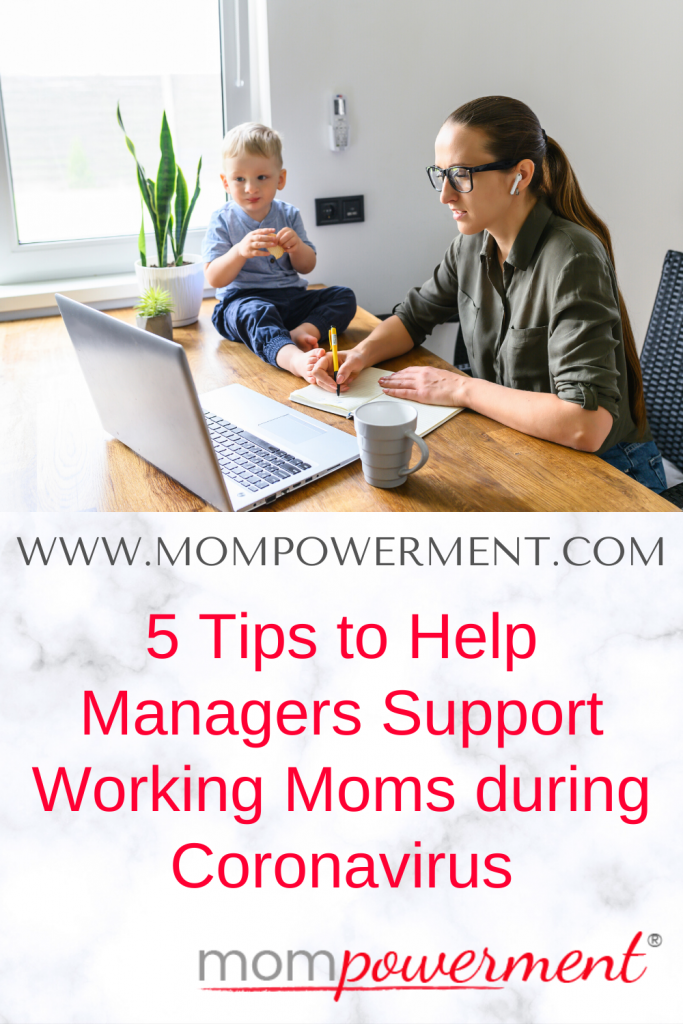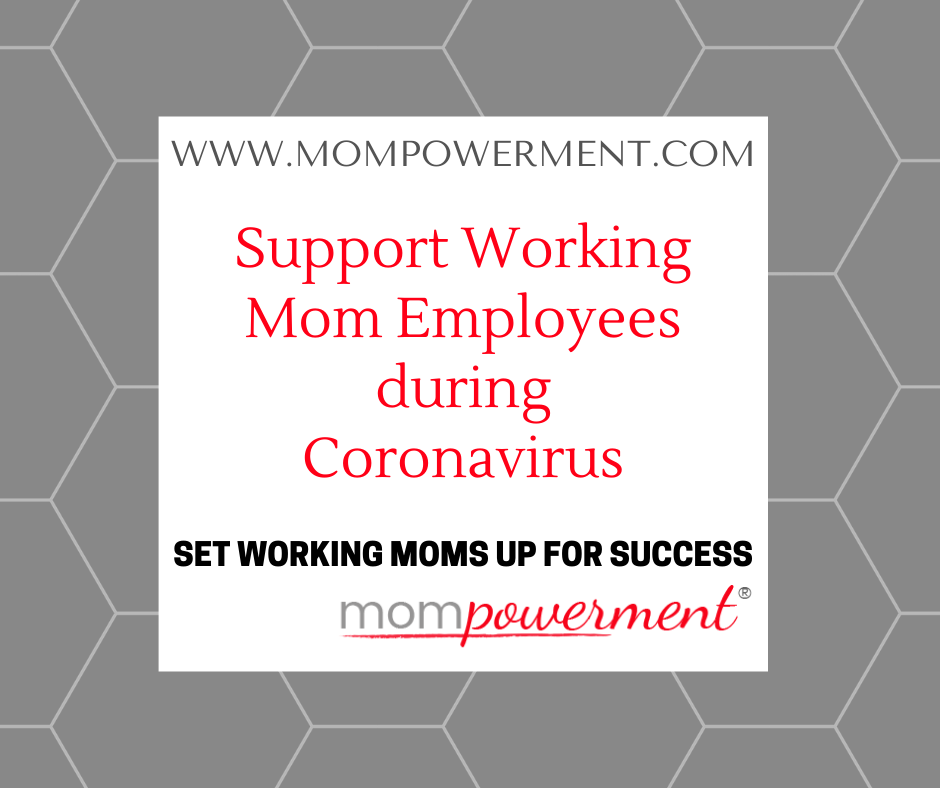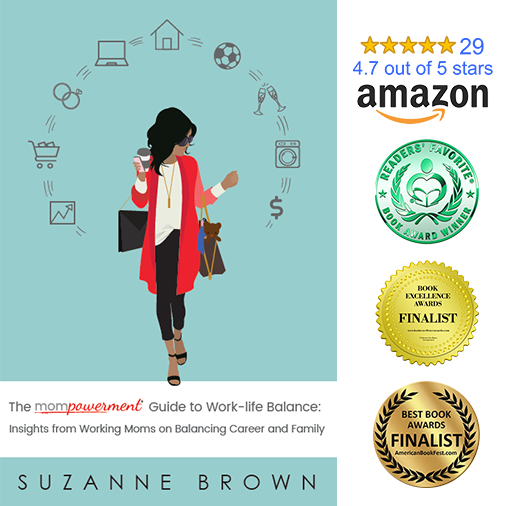
It’s been months since the US and the world have made some drastic changes because of coronavirus. Overnight companies closed their offices and shifted to remote work. At that same moment, schools transitioned to remote learning with little to no notice. Working moms especially are trying to manage all the things – meet deadlines, help their kids successfully maneuver remote learning (or stay entertained this summer), get dinner on the table, manage the household, etc. The list goes on and on. I’m sharing with you 5 ways to support working mom employees during coronavirus.
Be flexible
If there has ever been a moment for flexibility to allow people to work when and how they need, this is that moment. Period. If you don’t need your employees at specific meetings, the focus should be on people completing their work when it’s due, not on tracking every last minute they are at their desks.
Should it matter if that working mom or dad is visibly available online all day as long as he or she responds to work communications, whether internally or externally, in a reasonable time (hint: agree to what this period of time is ahead of time). Does it make a difference if Mary or John turns in whatever needs to be done at 3 pm or 8 pm as long as it’s in whoever’s inbox is touching it next? Should you be measuring results more and butts in seats less?
Flexibility requires trust, which hopefully you have since you hired the employee. And it requires an understanding of the bigger picture. Does when and how people work matter as long as there are doing a good job and meeting deadlines? If so, why? That’s how it’s always been might not be an appropriate response here. What if you have a night owl on your team or someone who wakes up crazy early to take advantage of a quiet house?
Do your employees need to help their children with remote learning? Do you really need that working mom (or dad) to choose between work and their child’s education? Chances are the answer is no. Being more flexible will allow her (or him) to succeed and you’ll still have a great work product if you give a bit more flexibility. And remember that many schools are only providing remote learning, at least for several weeks as the school year starts, so the need for flexibility is pretty consistent right now.
Meetings with purpose that are action-oriented
Does your team have back to back to back to back meetings? You get it. You have so many meetings that fill your workday, so employees must work in the evening or wee hours to get the actual work done. If so, are your meetings maximized? Is this the time to change things?
Even if you don’t have back-to-back meetings every single day, are you being efficient and effective with your meeting time? You want employees to have time to think and work and not just in the fringe hours of the day (e.g., after dinner and the crack of dawn). You’ll get a better work product from employees if they actually have downtime. When your brain has downtime, you are more productive. You have the space to think, make better decisions, and do better work.
And keep in mind that there is such a thing as Zoom fatigue. You can see more on this recent BBC article. To combat this, allow employees to turn off their video and consider limiting the number of meetings you have. Some organizations are having teams vote on ideal times to have meetings. Meetings are during a specific time of the day and everyone knows what to expect and can plan accordingly.
I did a whole blog about maximizing meetings recently, so I won’t repeat all of that here. Here are a few highlights: know the objective of the meeting, send out an agenda and give homework before a meeting happens, have meetings be action-oriented, keep a parking lot of related topics to stay on topic during the meeting itself, and do a follow-up communication that includes post-meeting action.
Review and adjust company benefits
Right now is the perfect moment to look at benefits and the general “package” you’re offering to employees, whether it’s your general package or specifically for the duration of the coronavirus. I’ve read about companies offering additional Personal Time Off (PTO) that employees can use for anything, especially to care for sick family members or manage remote learning for kids. Companies are offering webinars and training on different aspects of wellness (learn more about Mompowerment’s speaking topics).
Is this a good time to provide tutoring to employees’ children? Maybe you could provide online or in-person backup childcare. You never know when families will need this during the school year. (This is important for non-coronavirus times as well, so keep that in mind.) Are there mental health tools and/or resources that could be helpful? What about engaging tools and resources to help people be more mindful in this stressful time?
It’s helpful to ask employees what they need to succeed now and in the future. Don’t guess what employees need because you could be wrong. Enable your human resource (HR) team to strategically use their time and energy. Don’t waste HR’s efforts and your budget on benefits that employees really don’t care about.

Enable honest conversations
Communication is incredibly important right now. This is the moment for an open-door policy for all employees, not only working moms and dads. Employees might be nervous about their job security, struggling with managing all the things, taking care of ill family members, among other challenges. They could also want to share wins with you. Employees shouldn’t stop self-advocating now. We need open, honest conversations with employees as managers and senior leaders.
As senior leaders, we must gauge how people are doing. It’s not as simple as, “How are you?” We need to dig a bit deeper. Ask about what’s going well. Take time to understand what’s frustrating your working moms and dads and how you can help address those challenges.
We need teammates and especially managers to notice the verbal and non-verbal cues on Zoom calls. Use active listening skills to ask follow-up questions when someone talks about stress. If someone talks about their spouse losing his/her job or getting sick, ask how that is impacting your employee and his/her family. Does your employee need someone to listen? Can you shift how the challenge is framed to help create or find a solution?
It’s not about simply saying “I’m sorry” and moving on to the work task at hand. It might be uncomfortable, but it’s better to get someone help or resources than to avoid feeling uncomfortable.
We also need to hear about expectations upfront. If employees are being measured in a specific way right now, let them know that upfront. This is not the moment to spring something new that employees never heard about or even considered. Let them know what you’re looking at and measuring, so they make sure to spend time and energy on that area.
Relationship-building
In stressful times, we might have more of an inclination to hunker down and focus on our own needs (e.g., focus only on family). Connection is incredibly important in stressful times. Shawn Achor, happiness researcher and New York Times bestselling author shares in The Happiness Advantage that “Countless studies have found that social relationships are the best guarantee of heightened well-being and lowered stress…and a prescription for high performance.” Consider how as a manager or as a company leader, you can facilitate those relationships at work.
For starters, consider your own relationship with your employees. In The Happiness Advantage, Achor explains, “Studies have found that the strength of the bond between manager and employee is the prime predictor of both daily productivity and the length of time people stay at their jobs.” You must have an effective relationship with your employees so that they are making things happen and sticking around.
Can you give people ideas on questions to ask or things you should know about each other, both professional and personal topics? In the past, knowing those personal details – how many kids and what ages, personal interests, hobbies, etc. – helped me be better at my job. This approach helped me connect with my teammates and clients. My teammates and clients knew I cared. I had a new perspective so that I knew why someone needed to leave early and I felt compelled to be more of a teammate in times of crisis.
If you have a mentor program, how can you get more people engaged with a mentor? Help working moms find a new mentor. Consider how can you facilitate these interactions because they can happen online or in-person later. Help create more structured conversations. Don’t have a mentorship program but want to create one? Check out my blog post on this to help you.
***********************************************
Now that I’ve shared 5 tips to support working mom employees during coronavirus, what else would you add? What is working for you as you support your employees? What areas are you struggling with as a manager to working moms? How can Mompowerment help?
Check out more ideas from the Mompowerment 4-part series on how employers can support working parents. Don’t forget that Mompowerment can do hourly, half-day, or full-day strategy sessions to help you become more balance friendly, especially during this challenging time.


